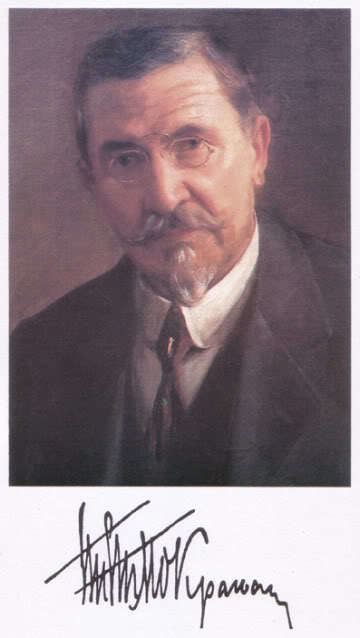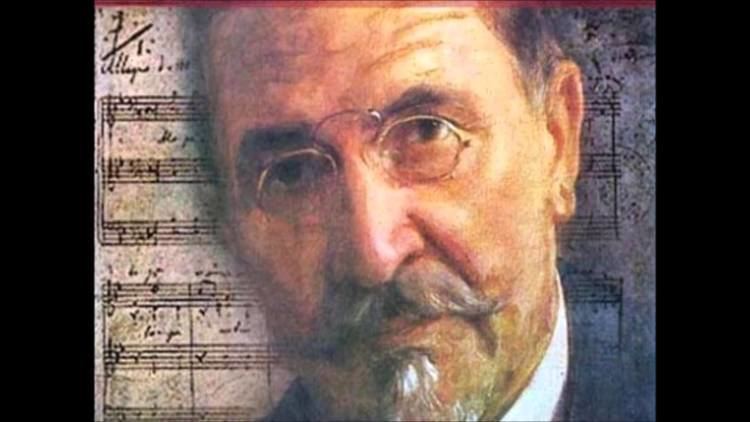Nationality Serbian Name Stevan Mokranjac | Children Momcilo Mokranjac | |
 | ||
Occupation ComposerMusic educatorConductorFolk collector Notable works fifteen Rukoveti, Tebe pojem, Cherubic Hymn | ||
Second stasis by serbian composer stevan mokranjac
Stevan Stojanović (Serbian Cyrillic: Стеван Стојановић, [stêʋaːn stojǎːnoʋitɕ]; 9 January 1856 – 28 September 1914), known as Stevan Mokranjac (Мокрањац, [stêʋaːn mokrǎːɲats]) was a Serbian composer and music educator. Born in Negotin in 1856, Mokranjac studied music in Belgrade, Munich, Rome and Leipzig while in his twenties. Later, he became the conductor of the Belgrade Choir Society and founder of the Serbian School of Music and the first Serbian string quartet, in which he played the cello. He left Belgrade at the beginning of World War I and moved to Skopje, where he died on 28 September 1914.
Contents
- Second stasis by serbian composer stevan mokranjac
- Heruvimska pesma Cherubic hymn composer Stevan Mokranjac schola cantorum university of arkansas Be
- Biography
- Compositions
- Legacy
- References
Often called the "father of Serbian music" and the "most important figure of Serbian musical romanticism", Mokranjac is well-regarded and much revered in Serbia. Following his death, the Serbian Music School was renamed the Mokranjac Music School in his honour. He has been featured on the country's paper currency and that of the Federal Republic of Yugoslavia. In 1964, the Mokranjac family home in Negotin was restored and turned into a museum and musical centre. Celebrations of Mokranjac's life, known as "Mokranjac days", have occurred annually in the town since 1965. In 1981, a large statue of Mokranjac was constructed in the yard of the Mokranjac family home to mark the 125th anniversary of his birth.

Heruvimska pesma Cherubic hymn composer Stevan Mokranjac, schola cantorum university of arkansas, Be
Biography

Stevan Stojanović was born on 9 January 1856 in the town of Negotin, Principality of Serbia. Close to the Serbian border with Romania and Bulgaria, Negotin was a small town of just over 3,000 inhabitants at the time of his birth. Stojanović earned the nickname "Mokranjac" after the village of Mokranje, where his ancestors were from. Mokranjac's father, a prosperous restaurant owner who in 1850 had built the house in which the Stojanović family lived, died two days before his son's birth. Growing up with his mother and three siblings, Mokranjac received his first violin at the age of ten. He spent most of his youth in Negotin, Zaječar and Belgrade.

In his twenties, he was subjected to conservative musical training and first studied in Belgrade. He went on to study in Munich with Josef Rheinberger from 1880 to 1883, and in Rome with Alessandro Parisotti in 1884–1885. Afterwards, he studied for two years in the city of Leipzig under Salomon Jadassohn and Carl Reinecke.
In 1878, Mokranjac arranged a concert commemorating the twenty-fifth anniversary of the Belgrade Choir Society, titled "The History of Serbian Song" (Serbian: Istorija srpske pesme). He and his family lived in their family home in Negotin until 1883. In 1887 Mokranjac made a permanent move to Belgrade, where he became the conductor of the Belgrade Choir Society, a position he would hold until his death. The choir was successful both in Serbia and abroad and under his leadership it became respected and well-known throughout Central Europe and Russia because of its high performance standard and repertoire, which was made up of many Serbian folk songs, as well as pieces composed by Mokranjac himself. It toured Bulgaria, Croatia, Montenegro, Ottoman Turkey, and Russia. In 1899, the choir toured Berlin, Dresden, and Leipzig. During this time, Mokranjac married Marija, a member of the choir who was twenty years his junior. The couple had one son, Momčilo.
Mokranjac founded the Serbian School of Music in 1899, as well as the first Serbian string quartet, in which he played the cello. Although his most famous works date from the late 19th century, Mokranjac continued composing during the 1900s. In mid-1914, he left Belgrade and moved to Skopje to escape World War I. He died here on 28 September 1914.
Compositions
Early in his career, Mokranjac recorded Serbian Orthodox church chants in staff notation. A gifted composer, he first published a book of church melodies in 1908, titled Octoechoes or "Eight Tones" (Serbian: Osmoglasnik). Published in Belgrade, it became the basic textbook for students in Serbian Orthodox seminaries following World War I. Mokranjac's chants were unique because he removed their ornamental and microtonal elements and harmonized them, making them distinct from other Eastern Orthodox church chants. Consequently, chants written by Mokranjac were used more than those written by other composers. Older versions of church chants were suppressed or forgotten.
Later melodies, drawn from oral tradition, were published posthumously. Mokranjac also composed many pieces of sacred music in a polyphonic style similar to that of Italian Renaissance composer Giovanni Pierluigi da Palestrina. Travelling often to Levač and Kosovo to collect and record traditional melodies, Mokranjac played a significant role in promoting music from the rural areas of Serbia. A composer committed to choral music, he achieved this partly by his composition of fifteen choral suites to which he gave the name "Garlands" (Serbian: Rukoveti), made up of a total of eighty-two songs composed from 1883 to 1913.
Mokranjac composed The Divine Liturgy of St. John Crysostom and Ivko's slava in 1901. In 1906, he created a mixed chorus version of The Glorification of Saint Sava, which was originally composed for a male chorus in 1893. In 1913, Mokranjac composed the eighty-second and final piece of "Garlands", titled Winter Days (Serbian: Zimski dani). He also composed numerous songs for children's choir.
Legacy
Considered the "father of Serbian music" and the "most important figure of Serbian musical romanticism", Mokranjac is well-regarded and much revered in Serbia. His works are considered the corner stones of Serbian music theatre. Serbian Orthodox chants recorded by Mokranjac and other composers form the basis of most modern Serbian church singing.
The Serbian Music School, which Mokranjac founded, was renamed the Mokranjac Music School after his death. He has been featured on the paper currency of both the Federal Republic of Yugoslavia and Serbia. In 1964, the Mokranjac family home in Negotin was restored and turned into a museum and musical centre. Celebrations of Mokranjac's life, known as "Mokranjac days", have occurred annually in the town since 1965. In 1981, a large statue of Mokranjac was constructed in the yard of the Mokranjac family home to mark the 125th anniversary of his birth.
He is included in The 100 most prominent Serbs.
